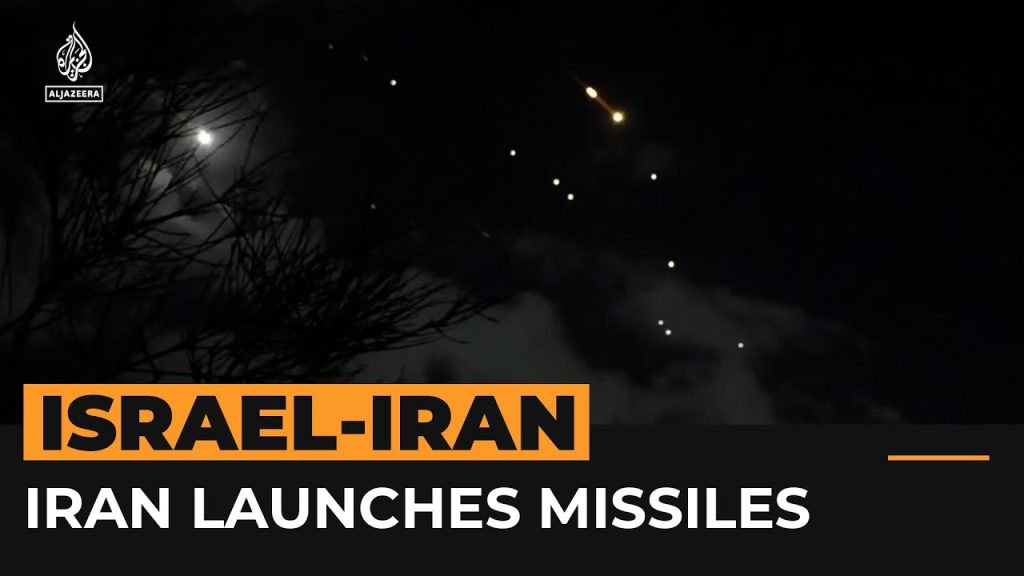Growing Tensions in the Middle East: Risks of a Full-Blown War
We must exercise extreme caution in analyzing the recent developments in the Middle East. The flashes in the sky we observed may well be interceptions—interceptions of projectiles, possibly missiles launched from Iran. Reports indicate that one, two, or even three of these projectiles may have hit their targets. The target in question? Tel Aviv. While some interceptions seemed successful, it’s unclear whether others struck their intended marks.

For over a year now, experts have been speculating whether this ongoing conflict could spiral into something bigger—into a direct, full-blown war. As we witness a direct hit on Tel Aviv, it’s evident that the situation could be on the brink of an escalation. Let’s delve deeper into the factors contributing to this volatile situation and the potential consequences of such an escalation.
Interceptions in Tel Aviv: A Turning Point?
In recent times, the sight of flashes lighting up the night sky has become disturbingly frequent. These flashes are likely a result of the Israeli defense systems intercepting incoming projectiles from Iran. While many missiles have been intercepted, at least one appeared to land in Tel Aviv, signaling a significant escalation. The potential for Iranian missiles to penetrate Israeli defenses and reach urban areas marks a turning point in the conflict.
The ongoing confrontations are no longer isolated incidents but rather show a systematic increase in hostilities. These developments raise important questions. How close is the region to entering an all-out war? Will this localized conflict spill over into a larger regional or even global confrontation? As the situation unfolds, many experts believe we may be heading toward a full-scale escalation with far-reaching consequences.
The Involvement of Major Actors: Israel, Iran, and the U.S.
The growing tensions between Israel and Gaza, and Israel and Hezbollah, bring with them a significant risk of major regional confrontation. The most prominent actors in this unfolding drama are Israel, Iran, and potentially the United States. The current situation is much more complex than it initially appears.
Israel and Its Regional Challenges
Israel has faced a range of threats for decades, from both state and non-state actors. The escalation in Tel Aviv marks a shift in the intensity of the threat it faces from Iran. The defense systems in place, such as the Iron Dome, are highly capable but not infallible. The recent strike on Tel Aviv demonstrates that the risk of civilian casualties and large-scale damage is now a harsh reality.
Israel’s government is in a precarious position, needing to balance domestic pressures for retaliation with the potential fallout of escalating into a broader conflict. Tel Aviv, as a major population center, symbolizes the heart of Israel, and a direct hit on this city has profound implications for both the morale of the Israeli public and the government’s next course of action.
Iran’s Role and Motivations
Iran’s recent missile launches into Israel mark a significant escalation in their ongoing confrontation. Iran’s motivations are multifaceted—its rivalry with Israel is based on ideological, geopolitical, and strategic reasons. Iran’s influence over groups such as Hezbollah and its willingness to challenge Israel directly by launching missiles indicate a desire to project power and establish dominance in the region.
However, Iran is also wary of the repercussions of such actions. A direct confrontation with Israel could provoke international backlash, and potentially draw the U.S. further into the conflict. Despite these risks, Iran appears determined to continue its aggressive stance against Israel, potentially seeing this as an opportunity to gain regional influence and rally domestic support against a perceived external enemy.
The Potential Role of the United States
The United States has traditionally been a strong ally of Israel, providing both military and diplomatic support. Should the conflict escalate further, the U.S. may be compelled to intervene more directly. American involvement could vary from increased military aid to direct military action, depending on the severity of the conflict.
However, U.S. involvement carries significant risks. It could inflame tensions with other regional actors, such as Russia or Turkey, and could lead to a prolonged conflict in the region. The U.S. is currently weighing its options, balancing its support for Israel with the desire to avoid being dragged into yet another prolonged Middle Eastern conflict.
The Risk of a Major Regional Confrontation
For over a year, many analysts and commentators have warned that the situation between Israel and Gaza, as well as Israel and Hezbollah, carries the risk of a major regional confrontation. The current developments, with over a hundred missiles launched from Iran, seem to be a further salvo in this ongoing confrontation.
The Broader Regional Dynamics
The Middle East is a complex web of alliances and rivalries, and any escalation between Israel and Iran could draw in multiple countries, turning a localized confrontation into a full-scale regional war. Hezbollah, an Iran-backed militia group based in Lebanon, could become actively involved, opening a new front against Israel from the north. Such a scenario would stretch Israel’s defenses and significantly increase the intensity of the conflict.
Moreover, countries like Saudi Arabia and the United Arab Emirates, which are opposed to Iranian influence in the region, could find themselves indirectly involved. Their interests lie in curbing Iran’s influence, and they could support Israel in ways that might provoke a retaliatory response from Iran and its allies. The entire region stands on a knife-edge, with the potential for widespread conflict.
The Humanitarian Impact
A major regional war would have catastrophic humanitarian consequences. Civilians in Israel, Iran, Gaza, and Lebanon would be at the forefront of suffering, with large-scale displacement, casualties, and destruction of infrastructure. The escalation of hostilities could also hinder access to basic needs, such as food, water, and medical care, further exacerbating the humanitarian crisis.
Additionally, the broader international community would likely be affected. A conflict of this magnitude would lead to an influx of refugees into neighboring countries and possibly Europe. International aid organizations would face enormous challenges in providing support amidst the chaos.
Prospects for Diplomacy and De-Escalation
Given the growing risk of an all-out war, the international community is likely to push for diplomatic efforts to prevent further escalation. The United Nations and other international actors may call for an immediate ceasefire and the resumption of dialogue. However, with emotions running high and trust between the parties at an all-time low, achieving a meaningful diplomatic breakthrough could be challenging.
The Role of International Organizations
Organizations like the United Nations, the European Union, and regional coalitions may need to step up their efforts to mediate between Israel and Iran. The international community must emphasize the need for restraint and call for a de-escalation of hostilities. It is in everyone’s interest to prevent a regional conflict that could have global repercussions.
Obstacles to Peace
However, there are significant obstacles to peace. Deep-seated mistrust, conflicting interests, and domestic political pressures make it difficult for both sides to engage in dialogue. Iran’s involvement with proxy groups like Hezbollah and Israel’s focus on maintaining its security make compromise challenging. The road to peace is fraught with complexities, and it will take considerable effort from all parties to move toward de-escalation.
Standing at the Precipice of War
The recent flashes in the sky over Tel Aviv serve as a stark reminder of how precarious the situation in the Middle East has become. The interceptions of projectiles, the direct hit on Tel Aviv, and the ongoing confrontation between Israel, Iran, and potentially the United States all point to the increasing risk of a full-blown war.
The situation is fluid, and the actions taken by the involved parties in the coming days will determine whether the region descends into chaos or steps back from the brink of a catastrophic conflict. International intervention, diplomatic engagement, and a commitment to peace are needed now more than ever to prevent a tragedy of immense proportions.
